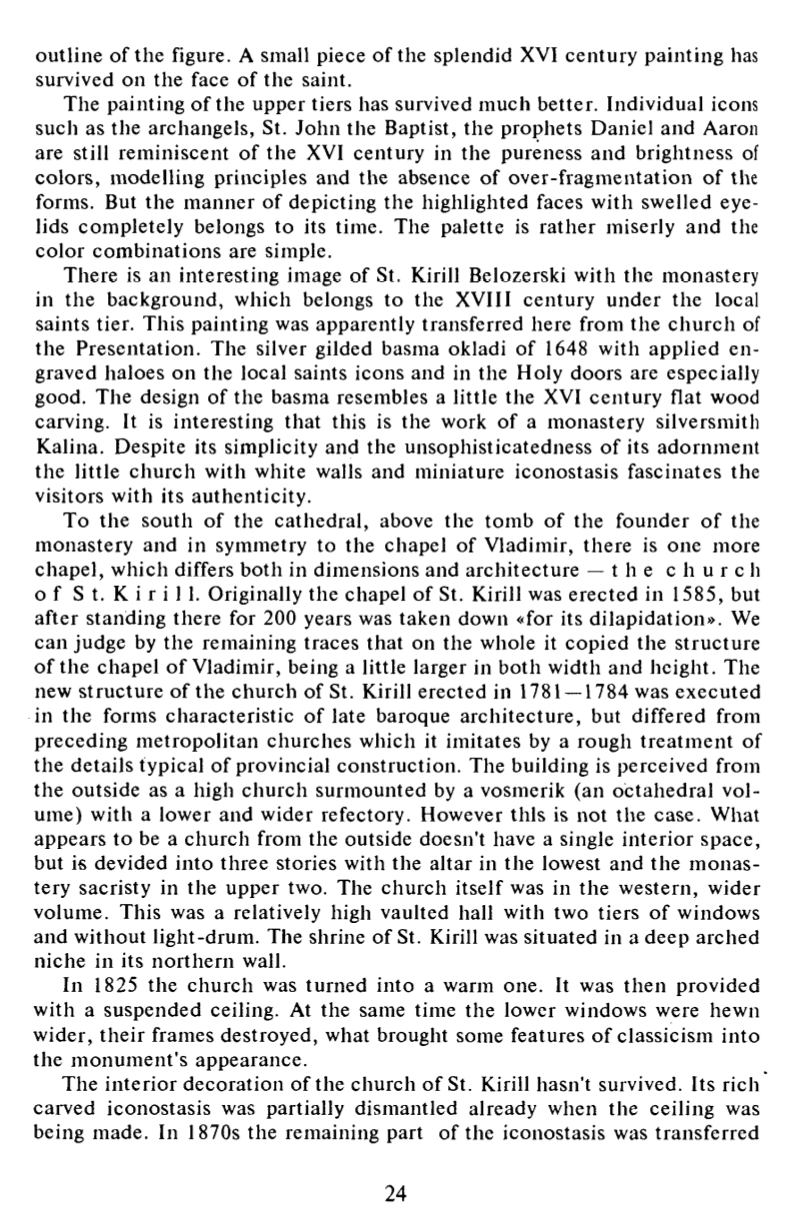

outline of the figure. A small piece of the splendid XVI cen tury pain ting has
survived on the face of the saint.
The painting o f the upper tiers has survived much better. Individual icons
such as the archangels, St. John the Baptist, the prophets Daniel and Aaron
are still reminiscent o f the XVI century in the pureness and brightness of
colors, modelling principles and the absence of over-fragmentation o f the
forms. But the manner of depicting the highlighted faces with swelled eye
lids completely belongs to its time. The palette is rather miserly and the
color combinations are simple.
There is an interesting image of St. Kirill Belozerski with the monastery
in the background, which belongs to the XVIII century under the local
saints tier. This painting was apparently transferred here from the chu rch of
the Presentation. The silver gilded basma okladi of 1648 with applied e n
graved haloes
011
the local saints icons and in the Holy doors are especially
good. The design of the basma resembles a little the XVI cen tu ry flat wood
carving. It is interesting that this is the work o f a monastery silversmith
Kalina. Despite its simplicity and the unsophisticatedness o f its adornment
the little chu rch with white walls and miniature iconostasis fascinates the
visitors with its authenticity.
To the south of the cathedral, above the tomb o f the founder o f the
monastery and in symmetry to the chapel of Vladimir, there is one more
chapel, which differs both in dimensions and architecture — t h e c h u r c h
o f S t. К i r i 1 1. Originally the chapel of St. Kirill was erected in 1585, but
after standing there for 200 years was taken down «for its dilapidation». We
can judge by the remaining traces that
011
the whole it copied the structure
o f the chapel o f Vladimir, being a little larger in both width and height. The
new structure of the church of St. Kirill erected in 1781 —1784 was executed
in the forms characteristic o f late baroque architecture, but differed from
preceding metropolitan churches which it imitates by a rough trea tmen t of
the details typical of provincial construction. The building is perceived from
the outside as a high chu rch surmounted by a vosmerik (an octahedral vo l
ume) with a lower and wider refectory. However this is not the case. What
appears to be a church from the outside doesn't have a single in terior space,
but is devided into three stories with the altar in the lowest and the mon a s
tery sacristy in the upper two. The church itself was in the western, wider
volume. This was a relatively high vaulted hall with two tiers o f windows
and without light-drum. The shrine of St. Kirill was situated in a deep arched
niche in its no rthe rn wall.
In 1825 the chu rch was turned into a warm one. It was then provided
with a suspended ceiling. At the same time the lower windows were hewn
wider, their frames destroyed, what brought some features o f classicism into
the monumen t's appearance.
The in terior decoration of the church o f St. Kirill hasn't survived. Its rich
carved iconostasis was partially dismantled already when the ceiling was
being made. In 1870s the remaining part of the iconostasis was transferred
24















